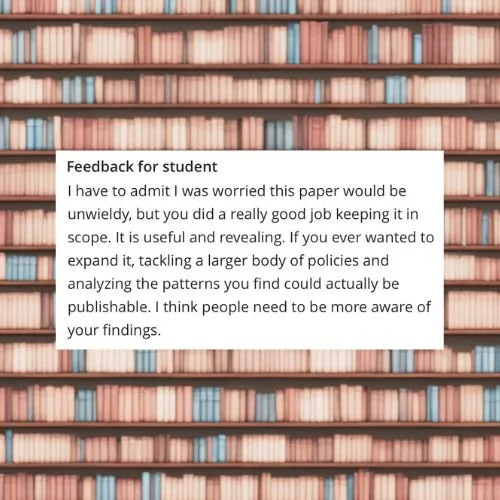Demonstrate information literacy and technological agility.
Program Learning Outcome #5
Beginning this Master’s program marked a completely new direction for me, as I had never worked in a library before. During my first semester, I took IST 605: Reference & Information Literacy Services. The course introduced various definitions of information literacy, which immediately resonated with me. It reflected the approach I’ve always taken to research: identifying what I don’t know, finding reliable sources, formulating effective searches, and critically evaluating credibility. Through this course, I deepened my understanding of information literacy and learned to assess sources using a diverse range of filters.
In my professional experience, I’ve often stepped into the role of an unofficial IT resource for my team. I enjoy exploring how technology can enhance efficiency and productivity, whether it’s mastering advanced features in Microsoft Excel to streamline data analysis or troubleshooting a video projector system for a global meeting. These experiences have established me as a go-to technology leader within my work teams, a role I genuinely enjoy.
5.1 Exercise expert information literacy skills including the ability to identify information needs, search, evaluate, produce, and use information ethically.
Incorporating the media literacy segment into the podcast episode was an exciting opportunity to apply my information literacy skills and deliver reliable, well-researched content to listeners. It felt like conducting a reference transaction with myself! I realized that media literacy closely mirrors information literacy, particularly in the evaluation process. To foster transparency and empower the audience, I included direct links to all my sources in the episode description. This not only properly cites my references but also equips listeners with the resources to make their own informed decisions.
In my IST 605: Reference & Information Literacy Services course, I applied my information literacy skills to a reference scenario for my final project. As part of this project, I created an executive summary to provide my "patron" with a concise overview of the information discovered during the reference transaction. The accompanying transcript highlights my ability to guide a patron through the entire information literacy process. Additionally, the transcript is annotated to showcase the reference standards I applied throughout the interaction, demonstrating my commitment to professional best practices.
5.2 Apply knowledge of user information behavior in various contexts.
Understanding your audience is crucial when leading instructional sessions. As a librarian, you often don’t have the advantage of knowing your students in advance, making it even more important to develop a thorough understanding of your learners and the broader community. This insight is essential for setting the stage for success. In IST 662: Instructional Strategies for Information Professionals, I created a lesson plan that emphasizes strategies for assessing students’ needs and understanding the knowledge they bring to the classroom. Acknowledging the diversity of learning styles, I incorporated a variety of learning theories and methods to address different preferences. Additionally, my lesson plan includes built-in comprehension checks to ensure students grasp the material before advancing. This approach creates a more inclusive and effective learning experience.
5.3 Employ research methods to investigate important questions; collect, analyze, evaluate, and communicate data; and interpret results from studies in library and information science and cognate fields.
The IST 715: Libraries, Archives, and Museums course offered a unique opportunity to combine my passion for collection development with my interest in data analysis. For my final project, I analyzed collection development policies, gathering data from libraries, archives, and museums to compare their practices against the guidelines of leading professional organizations. I found that the museums I reviewed were particularly effective in adhering to the collection development standards set by their respective professional bodies. The feedback I received from my professor was glowing, stating “I think people need to be more aware of your findings.” which was deeply humbling.
5.4 Engage, evaluate, and deploy various technologies ethically and critically.
In IST 564: Accessible Library & Information Services, we explored various ways technology can help remove barriers faced by individuals with disabilities when accessing library services. I found it fascinating that assistive technology isn’t limited to electronic tools like screen readers or automatic doors; even adaptive seating can be considered a form of assistive technology. For my assistive technology report, I evaluated five current technologies used at the library and recommended five additional technologies to incorporate. It’s crucial to consider not only those with visible disabilities, but also individuals with invisible disabilities, in order to create an inclusive and welcoming environment for all.
Conclusion
Technology is constantly evolving, and as library leaders, it is essential that we remain proactive in exploring both current and emerging technologies. By doing so, we can enhance the services we offer our patrons and make more informed, strategic decisions. One area I recognize the need to explore further is artificial intelligence. AI is a technology that is here to stay, and it’s crucial for me to understand both its potential benefits and its risks. Gaining a deeper awareness of AI will not only enable me to better educate my community but also help me navigate its challenges safely.
Notice: All personally identifiable information related to individuals, libraries, or locations has been omitted from my program work product.
